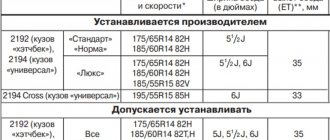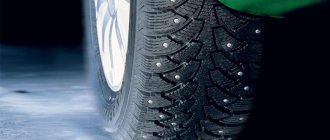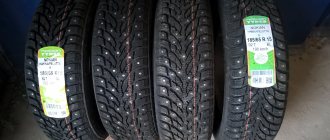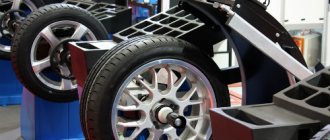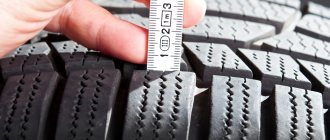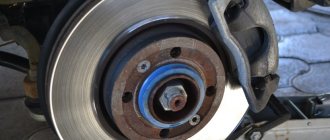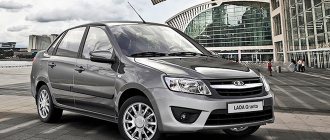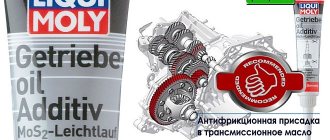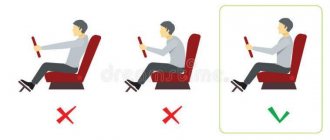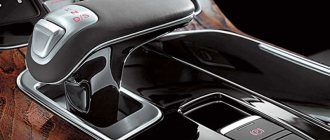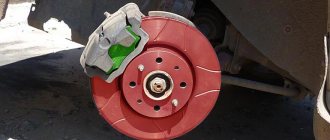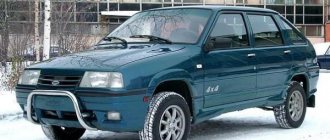Added Dec 29, 2013 in Tests, Tire tests
The testing involved both tires from popular manufacturers that have already proven their worth in creating studded tires, as well as several little-known models. Test conditions are as close as possible to real ones.
Separate tests were carried out during the thaw on dry and wet asphalt. At the test site in Ivalo, tire tests were carried out on ice and snow: lap times, snake, rearrangement, braking. To eliminate the human factor, the tests were repeated 20-30 times, after which the crew was replaced and the tests were performed another 20-30 times. The results were averaged.
Michelin X-Ice North 2
Michelin X-Ice North 2
A French product, aimed mainly at the Scandinavian countries and Russia. The specifics of the winter weather in this area determined the features of the tread pattern. The changes are rather evolutionary in nature; there are triangular cutouts on the side tread blocks - for improved cross-country ability, the number of lamellas has been increased by 7% compared to the previous model. The central tread blocks are activated alternately, reminiscent of a tractor caterpillar. For diameter r14 the following profiles are available: 175/65, 175/70, 185/60, 185/65, 185/70. The tests were carried out on a set of 185/65 r14 tires.
A 12-row stud is used. Unlike most competitors, the tenon is not faceted, but round, double-flange. According to the manufacturer, braking distance on icy roads is reduced by 10% compared to the previous model. The special composition of the rubber mixture keeps the tire elastic even at -60°C (tests were carried out in a freezer).
On ice it shows excellent grip characteristics. There is a sense of understeer during tight corners, but the car handles perfectly in smooth corners. On a snowy road with frequent longitudinal grooves (simulating the work of snow blowers), the Michelin does not wobble from side to side. Fuel consumption is at an average level, as are acoustic comfort indicators.
Judging by the reviews, during the break-in period they create discomfort at speeds above 90 km/h due to the noise level, after 3000 - 5000 km the problem disappears.
Test conditions
Traditionally, car tire tests were carried out in several categories:
- steering, braking and acceleration on snow;
- the same characteristics in icy conditions;
- performance on asphalt;
- degree of comfort during control;
- efficiency (fuel consumption).
The races were held at specialized training grounds under equal conditions (air temperature, precipitation, track quality). For testing, experts took the same car, and measurements were carried out using professional equipment.
Subjective indicators such as ride comfort and ease of control were determined by experienced pilots.
Dunlop Ice Touch
Dunlop Ice Touch
The tire tread is distinguished by the large width of the central rib. It is formed by separate blocks, grouped in groups of three. The larger width provides a larger area of contact between the tire and the road, which means more grip. The sipes on the tread blocks are multi-directional; some of them work in any direction of movement. With a diameter of r14, profiles 175/65 and 185/65 are available. The size tested was 185/65 r14.
The shape of the stud is unusual - the carbide core is equipped with sharp edges on the front side, this solution improves grip during acceleration. The back side of the stud is made with a larger cross-sectional area for effective braking.
Lateral grip is much worse than longitudinal grip. This manifests itself in the fact that when passing a “snake” the car often slips into a skid, the same thing is observed when turning on ice. On snowy roads, braking distances are the shortest, although acceleration is a bit sluggish and steering is delayed. The results on asphalt, both wet and dry, can be called excellent. Short braking distance, low rolling resistance, quick steering response, low noise.
Reviews speak in favor of the results obtained. The tires really show a balanced result on all types of winter roads. But given the weak lateral grip, they can be recommended for driving mainly on cleared or snowy roads.
Gislaved Nord Frost 100
Gislaved Nord Frost 100
The model has enlarged tread blocks; in order not to reduce the number of engagement edges, they are made in the form of polygons. The central rib is monolithic with deep slots. In the shoulder zone, the blocks are grouped in pairs; between the groups the width of the drainage channels is increased. Diameter r14 is available in 6 sizes: 155/65, 175/65, 175/70, 185/60, 185/65, 185/70. Tires tested were 185/65 r14.
To reduce the weight of the tire, the main part of the stud is made of aluminum. The total height of the spike is 11 mm, and the diameter is 8 mm. For strong fastening in the tire, the invisible part is made in the form of a star with three vertices, thanks to which the studs received the code name TriStar CD.
The test results allow us to recommend the model for off-road and any winter road. On wet and dry roads the car does not slip, there is no hydroplaning, although there is a slight delay in the response to control. It showed excellent performance on roads with deep ruts, high cross-country ability. On ice, the braking distance is short and stability is high in the transverse direction.
Reviews of the product complement the test results with the high strength of the studs, even with aggressive driving, the loss is no more than 2% per season. The noise is below average, after running in and warming up it is almost not felt in the cabin.
Formula Ice
Formula Ice
To reduce weight, aluminum studs with a hexagonal tungsten carbide core are used. The base of the cleat is reinforced to ensure a secure fit. The stud landing site is additionally reinforced with stiffening ribs on the surface of the tread block itself. A solid central rib ensures quick response to steering and high directional stability. With diameter r14, 5 profiles are available: 175/65, 175/70, 185/60, 185/65, 185/75. A set of 185/65 r14 tires was tested.
The tires performed confidently on the ice lap, showing the second result; there were also no problems when passing the snake. I slip a little when accelerating, but overall the ice holds up well. On snow, where spikes do not play a major role, the result is slightly better. When cornering, the skid is very slight and can be easily eliminated by turning the steering wheel and changing the traction. On asphalt at sub-zero temperatures the ride is smooth, but at temperatures above +5°C there is a slight delay in the reaction.
During operation in winter conditions, no significant deficiencies were identified. Reviews speak of good grip on ice and snow and mediocre performance at positive temperatures. However, in cold weather the performance improves. Taking this into account, tires can be recommended for icy and snowy roads.
Reviews about winter tires
Konstantin, Volgograd
“I purchased Yokohama Ice Guard as soon as it went on sale. I have used other models from this company before and I like them all. The tires are still rolling well, no complaints.”
Igor, Samara
“I drive the Continental, the third season is coming, everything is fine. They make a little noise, sometimes they don’t start right away if there is a lot of snow under the wheels, but overall everything is fine. I drive around the city and don’t go into hard-to-reach places.”
Kamil, St. Petersburg
“I took Michelin on my head. It was highly praised in the reviews, but in reality it turned out to be an unrealistically noisy tire that copes poorly with the road. The only plus is that the spikes are in place after 2 seasons, but the price is simply exorbitant.”
Anna, Ryazan
“I spent a long time choosing winter tires between continental and domestic Kama. I've been driving recently and don't have much advice, so I had to read reviews and go shopping. I still chose Kama and didn’t regret it. The wheels are reliable and have never let me down. The seller recommended the Euro 519 model, all the studs are in place.”
Kirill, Moscow
“I took a Nokian Nordman 7 Sun for an SUV. I realized that it was possible not to purchase such powerful tires for the capital’s roads, but I often drive in other regions, and they really save me. It handles maneuvers well, everything suits me, I think it will take a couple more seasons.”
Anatoly Ivanovich, Vitebsk
“I’m a fan of domestic products, I only take Kama. This is not the first season that wheels have come to the rescue. Another big plus is that no one will particularly covet it, so I don’t worry about being “taken off.” I recommend it to anyone who cares about quality, not brand.”
Igor, Krasnodar
“Our winter is mild, so I take Bridgestone Velcro. Handles wet roads well, the price is normal, it has never let me down. This season it’s time to change, I think I’ll buy the same tires again.”
Reviews about winter tires will be constantly updated!
You can also read on this topic:
The idle speed sensor for VAZ 2114 costs about 350 rubles
Purchasing a VAZ 2109 carburetor at a good price
Nissan Teana second generation with reliable engines
Do-it-yourself installation of a VAZ 2114 panel on a VAZ 2109 (carburetor)
How to change the oil in an automatic transmission correctly?
Share on social networks
Dmitry Seregin January 5, 2022
Published in: Useful tips and car devices
Tags: rating, Tires
Bridgestone Ice Cruiser 7000
Bridgestone Ice Cruiser 7000
For better grip on snow, the edges of the tread blocks have a zigzag shape. The central rib consists of diamond-shaped blocks interconnected. The spikes are arranged in 16 rows. Compared to the previous model, the print area is 16% larger. For better lateral grip, the tops of the studs are not round, but cross-shaped. The manufacturer claims that even under harsh operating conditions in urban areas, the loss of studs will not exceed 30% over 3 seasons. The tests were carried out on standard size 185/65 r14. Profiles available for this diameter: 175/65, 185/60, 185/65, 185/70, 175/70.
On a clean road at temperatures up to +7°C, the model provides good handling and short braking distance. On ice, the best result was recorded in passing the snake. It takes turns at speeds of 60-70 km/h with virtually no drift. On a snowy road the performance is worse - low lateral and longitudinal grip, average cross-country ability.
Operating experience has revealed such a disadvantage as increased rolling resistance at speeds above 90 km/h, which causes excessive fuel consumption. Rigid sidewalls allow you to withstand impacts when falling into holes. Quite noisy compared to competitors.
Other properties
Road behavior is the most important, but not the only characteristic of winter tires. Noise level is a discipline in which studless tires outright outperform any studded tire. The high level of comfort when driving on friction clutches often becomes a decisive argument in their favor. Velcro also avoids the risk of air leaking through the stud hole.
The ability to “change the shoes” of the car long before the first snow fell was previously considered an asset to the friction clutches. In fact, you need to switch to any winter tires at a temperature of +5-+7 °C.
Modern technologies and a high level of production minimize the loss of studs on hard surfaces; in addition, according to test results, studs on asphalt are almost as good as Velcro.
BFGoodrich G-Force Studded
BFGoodrich G-Force Studded
The design features a central longitudinal channel, dividing the tire into two equal halves. The tread blocks themselves are small in size, which creates a large number of sharp edges that bite into the snow. To quickly drain the contact patch, the transverse drainage channels widen by 40% towards the edge of the tire. The popular standard size 185/65 r14 was tested. With this diameter, sizes 175/65 and 185/65 are available.
The studs are made in 8 rows, and the location of the studs is chosen in such a way that at least 6 are in contact with the road at the same time. Changes also affected the design of the stud - the head is enlarged, the flange has a variable diameter, which increases the fastening strength by 30%.
The model showed good resistance to centrifugal force when passing through an ice circle. Uncertain results were recorded only when braking; in general, they grip the ice well. It accelerates slowly on snow, but demonstrates a short braking distance and slight drift when cornering. There are comments regarding directional stability on dry and wet asphalt.
Judging by statistics and reviews from motorists, fuel consumption is comparable to summer tires in any speed range. The tires are quite quiet up to 90 km/h. They smooth out uneven winter roads well.
Effect of temperature
The properties of ice at different temperatures differ markedly. In severe frost, it is more difficult for spikes to bite into hardened ice, while softer Velcro retains its adhesion properties. But on melted ice at near-zero and above-zero temperatures, friction tires cannot cope with the water layer in the contact patch and significantly lose efficiency.
This statement was proven by an experiment conducted by the magazine “Behind the Wheel” in 2009. At a temperature of -19 °C, the spikes performed worse in the braking test, losing up to 5.5 meters of braking distance to the Velcro ones. At -13 °C, both types of tires behaved approximately the same. But already at -5 °C Velcro may require an additional 31.3 meters to stop, and at -1 °C already as much as 58.3 meters. The advantage of studs with a slight disadvantage was also confirmed by Autoreview tests performed in 2016 and captured on video:
At the same time, in 2022, Autoreview experts discovered the progress of studded tires. Because even at –20 °C, Nokian and Gislaved studs showed superiority over friction models. Details in the video:
Kumho I Zen KW22
Kumho I Zen KW22
In the center of the tire there is a monolithic rib, along the edges of which there are triangular cutouts, its main function is to ensure quick response of the car. The design uses chaotically located tread blocks of different sizes. Wide lamellas are used in the central zone to reduce the braking distance, while narrow lamellas are used in the outer blocks. Diameter r14 is available in sizes: 165/65, 175/65, 185/60, 185/65, 185/70. A set of 185/65 r14 tires was tested.
Seven-sided spikes are used, the distance between them is fixed and is 3.5 inches. The silica included in the tread rubber is responsible for maintaining elasticity even in severe frost. The Korean manufacturer emphasizes that all components of the rubber mixture comply with environmental standards of the European Union.
Road grip on snow and ice is good, as evidenced by the short braking distance and short acceleration time. When turning on an arc, the car drifts, which indicates average lateral grip. The cross-country ability leaves much to be desired; movement on loose snow is only possible under pressure; when storming another snowdrift, you need to remember that the car can easily get buried and it will be very difficult to get out on your own.
The tires are quite economical, dampen winter road irregularities well, and the noise in the cabin is almost indistinguishable. Motorists highlight the lack of aquaplaning and stability on any winter road. In general, the model can be recommended for conditions that do not involve movement on virgin snow.
Sava Eskimo Ice
Sava Eskimo Ice
A symmetrical directional V-shaped tread pattern is used. Among the design features, it is worth noting drainage channels that have a large “angle of attack” and widen towards the edge of the tire, this increases the drainage properties of the tread. The tread blocks have the shape of polygons with non-through slots; the sipes are not very dense. Diameter r14 is available in three profiles: 175/65, 185/65 and 185/70. The popular standard size 185/65 r14 was tested.
The model is not suitable for driving on snowy roads and ice. Despite the 8-row studs, the tire performs poorly on ice. Starting from a standstill occurs with slipping, the braking distance is long, and the winding section is difficult for the car. On cleared asphalt, it skids when moving or turning. The only thing that can be noted is the fact that this skid is predictable and soft, but the tires react very sluggishly to steering.
Judging by the reviews, the presented model is best suited for driving on a mixture of snow and water and has excellent drainage properties. It is difficult to recommend tires for driving on winter roads.
Roadstone Winguard 231
Roadstone Winguard 231
The tread pattern is standard for tires in this category - symmetrical and directional. The central rib is solid and has a zigzag edge. The outer blocks are placed at an angle to the direction of movement. The studs are placed haphazardly, the manufacturer assures that this approach minimizes noise at any speed and does not impair traction. A set of 185/65 r14 tires was tested. With this diameter, the following sizes are available: 175/65, 175/70, 185/60, 185/65, 185/70, 195/70, 205/70.
RoadStone tires, despite loud statements from manufacturers, showed the worst grip performance on all types of surfaces. It seems that the studs not only do not improve handling on winter roads, but also worsen it. The result of measuring the braking distance (from 50 km/h to 0 km/h) is indicative - the tires lost even to their non-studded counterparts. This fact alone is enough to not even consider purchasing tires. The cross-country ability is low; on winter roads it takes a very long time to accelerate.
Motorists also agree with the test results; judging by their reviews, the tires are simply dangerous on winter roads. It seems that the manufacturer simply completed the studding of the summer model and did not bother anymore. Yes, they resist hydroplaning well and provide average handling on clean asphalt, but for winter tires these are rather auxiliary indicators. Final verdict - not recommended for use, despite the low price.
Continental ContiViking Contact 6 - a new development of the famous brand
German quality and advanced technology are an important aspect of high-quality car operation. Even if your car is not from Germany, you can give it certain qualities of the German level. Buy Continental ContiViking Contact 6 tires. This is a new generation of the famous and successful tire with the following important features:
- excellent operating options with an asymmetrical unusual tread;
- the rubber clings perfectly to any surface and holds the road better than its competitors;
- use of the best materials for the manufacture of tire tread and cord;
- unprecedented durability and optimal performance in different modes.
You can choose suitable tires for a long time among the offers of world brands, but still not find the best option. If you give preference to Continental tires, you will not have any operational problems. When choosing tires, pay special attention to the German Continental. This is often the best solution for your car.
Summarizing
The leadership of Michelin and Dunlop is beyond doubt; these tires are capable of providing comfort and confidence in any winter conditions. Of the tested models, special mention should be made of Sava and Roadstone, which not only have low performance, but simply pose a real threat to traffic safety. The rest of the test participants have clearly defined strengths and weaknesses. Based on this, they can be recommended for specific winter conditions.
